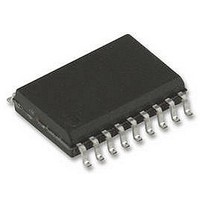TMC222-SI TRINAMIC, TMC222-SI Datasheet - Page 38

TMC222-SI
Manufacturer Part Number
TMC222-SI
Description
IC, MOTOR CTRL/DRVR, STEPPER, SOIC-20
Manufacturer
TRINAMIC
Datasheet
1.TMC222-SI.pdf
(47 pages)
Specifications of TMC222-SI
Motor Type
Stepper
No. Of Outputs
4
Output Current
800mA
Supply Voltage Range
8V To 29V
Driver Case Style
SOIC
No. Of Pins
20
Operating Temperature Range
-40°C To +125°C
Device Type
Motor
Lead Free Status / RoHS Status
Lead free / RoHS Compliant
Available stocks
Company
Part Number
Manufacturer
Quantity
Price
Part Number:
TMC222-SI
Manufacturer:
TRINAMI
Quantity:
20 000
38
7 Frequently Asked Questions
7.1 Using the bus interface
Q: How many devices can be operated on the same bus?
A: 32 devices can be discriminated by means of the physical address. However, it depends on some
factors if this high number really makes sense. First of all it has to be checked if each device can be
serviced under any circumstances in the maximum allowed time taking the bus speed and the
individual real-time requirements of each device into account. Second, the idea of reserving address
0 for OTP physical address programming during system installation and defective parts replacement
reduces the number to 30.
Q: How to program the OTP physical address bits of a device if there are more devices
connected to the same bus?
A: The problem here is that all new devices are shipped with the OTP physical address bits set to
zero making it difficult to address just one device with the SetOTPParam command. Use HW input as
chip select line to address just one device by SetOTPParam. If this is impractible since the HW input
is hardwired or not controllable for any other reason the only alternative is to assemble and program
one device after the other. I.e., assemble only first device and program the desired non-zero address,
then assemble the second device and program the desired non-zero address, and so on until all
devices are assembled and programmed. This is also a good service concept when replacing
defective devices in the field: The idea is that all devices are programmed to different non-zero
physical addresses at production/installation time. Once a defective device is being replaced the
replacement part can easily be addressed by SetOTPParam since it is the only part with physical
address zero.
7.2 General problems when getting started
Q: What is the meaning of ElDef?
A: The ElDef flag (‘Electrical Defect’) is the logical ORing of the OVC1 and OVC2 flags. OVC1 is set
to one in case of an overcurrent (coil short) or open load condition (selected coil current is not
reached) for coil A. OVC2 is the equivalent for coil B.
Q: What could be the reason for ElDef / OVC1 / OVC2 being set to one?
A: There are a number of possible causes:
Q: Should the external switch be normally closed or open when the reference position is hit?
A: The SWI input resp. the ESW flag have neither effect on any internal state machine nor on
command processing, even not on the RunInit command. ESW must be polled by software using
GetFullStatus1 command. The software can simply be adapted to whatever state the switch is in
when the reference position is hit, i.e. closed or open.
Copyright © 2004-2007 TRINAMIC Motion Control GmbH & Co. KG
•
•
•
•
Motor not connected (? open load)
Connected motor has shorted coils (? overcurrent) or broken coils (? open load)
Motor coils connected to the wrong device pins
Selected coil current can not be reached (? open load) due to high coil impedance or low
supply voltage. Solution: Select a lower coil run/hold current or rise the supply voltage.
Generally: the calculated voltage required to reach a desired coil current at a given coil
resistance (V = I • R) must be significantly lower than actual supply voltage due to the coil
inductivity.
TMC222 DATASHEET (V. 1.06 / March 15, 2007)














